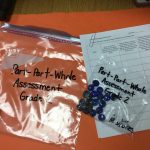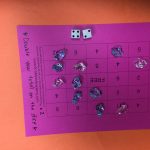In 2013, our school board, the York Region District School Board, launched the comprehensive math program, which involves the interconnections of the environment, the learners and the learning. This includes a focus on the role of math games in the classroom. Our primary school is a kindergarten to Grade 3 school with approximately 400 students, of which 160 are kindergarten students. Our staff have been exploring using math games on a regular basis in the classroom to help solidify a greater math understanding. Our team chose to focus on quantity because it is a foundation skill in number sense and numeration. With the current climate of getting back to the basics, we believe that games offer students voice and choice along with increased engagement while developing these skills.
Team Members
Carol Fortnum
York Region District School Board
Jennifer Muir-Birtles
York Region District School Board
Jacquelyn Bellamy
York Region District School Board
Professional Learning Goals
- Deepened our understanding of the learning trajectories related to foundational numeracy skills within primary grade students
- Created a praxis of theory and practice whereby we applied current research to practical tasks and activities such as games (individual, partner, small group and large group games)
- Created assessment tools to accompany the games based on the learning trajectories descriptors
Activities and Resources
We began by examining curriculum documents, the Guide to Effective Instruction, and the learning trajectories from Number Worlds by Clements and Sarama. We used the Early Number Concepts and Strategies chart developed by YRDSB to help us deconstruct the skills involved in numeracy. We landed on Quantity because, “…understanding the idea of quantity is an important prerequisite to understanding place value, the operations, and fractions.” (Guide to Effective Instruction, pg. 32). We created a survey of our staff to determine staff understanding in the areas of number sense and numeration, as well as the use of math games within their math programs. The survey showed that while many respondents believed in the importance and value of using games in their math program, they were unsure about their understanding of the concept of “part-part-part whole”. This lead us to narrow our focus to that area within the math skills continuum.
Coincidentally, within this time period, our board provided resources for staff development in the area of math. Our team presented our OTF/TLC project goals to the staff and seven other staff members were interested in learning more about implementing games in their classrooms. As a result, our school math team’s focus is also developing early numeracy games that will be stored in a common area for all to access. To support this initiative, we invited Heather Jelly, our board’s Early Years Math consultant, to provide in-service sessions on early numeracy games. This workshop launched our discussions on assessment tools and the importance of documenting student learning, and anticipating student responses.
Building upon the knowledge of our expanded math team, we learned about resources made available by one of our staff members, on our school’s Google Drive. She participated in online webinars over a 12-week period offered by Christine Tondevold whose website http://www.mathematicallyminded.com/ has many free resources. We used this resource bank of games to help us decide which games to implement that would best support our focus of part-part-whole skill development. We purchased and created the materials, and then set about using them with students who required further practice with part-part-whole.
Unexpected Challenges
We were approved for plenty of release time, and yet finding the “right time” for teachers to be released proved to be a challenge. For example, not too close to report card deadlines, not on 100thDay or Valentines Day, not too many teachers out at the same time, not on a Friday to ensure OT coverage, etc.
One of our team members experienced medical issues and had to be off work for an extended period of time, thus affecting our selection of learners and our overall impact within the school.
Our original goal of sharing the games at a staff meeting or through release time became untenable due to lack of time. However, we were able to share with our math team and we posted the information on our school Google Drive account.
Enhancing Student Learning and Development
It was observed by classroom teachers that students in grades one to three were struggling with the concept that quantities represented by numbers are made up of different parts (e.g., four counters and three counters make seven, and that is the same as five counters and two counters also making seven). Similarly, two-digit numbers were not seen as being composed of tens and ones.
This observation leads us to develop and promote games that would address the needs of students in a manner which was engaging and fun.
Our first observation was that students were highly motivated to practise this skill through the games.
One of the most popular games was Capture 4. We modified it so that there were multiple entry points for the students and no matter their level of understanding of part-part-whole, they could participate in the game by selecting the appropriate game board.
After attending professional development sessions with Cathy Twomey Fosnot on using Number Strings in the primary classroom, teachers are hearing more students using the language of part-part-whole, in their mathematical reasoning. For example, a Grade 2 teacher does a quick session on the Reckenreck where she models different combinations to 20 and students are quickly identifying the two parts.
Our team included a variety of manipulatives for the games, everything from stones to gems, to two-sided counters. We feel that providing students with a variety of materials helped keep the games engaging.
Also, we purchased commercial items and games such as Blockus, Dominoes, Bingo, decks of cards and Tenzies to allow students to explore part-part-whole in everyday games they may have at home. In addition, we added some digital games to our classroom iPads for yet another experience to their part-part-whole understanding that hopefully students would want to load on their personal devices at home.
Sharing
We were able to share our project goals and journey with a school-based math team of interested educators, who then expanded the project to include other areas of early number sense. We packaged the part-part-whole math games for all to use, and included an associated assessment tool for teacher usage. We shared these games through the school-based Google Drive account and placed the completed games in a common area for all teachers to use. Our board-assigned math days would not have been enough time to launch our vision for a shared games room and so the funding from OTF was critical. Teachers are responding well to the creation of these games and various materials we created and purchased. We are observing an increase in comfort level among staff in integrating math games into their comprehensive math program on a regular basis.
Project Evaluation
While the initial focus of this project was student engagement, voice and choice, what has resulted has been a lot of staff development of voice and choice. Teachers are talking about math games, collaborating and adding their own discoveries to our school Google Drive and shared math resources for our math room. There have been rich discussions among teachers related to how and when to implement games, the role of games and the assessment opportunities provided through games. There is a lot of excitement around having a wide variety of games that are vetted and organized, and readily available for teachers to use. While it will take more time to expand the quantity of these games and activities so that there is enough for all, the learning that has occurred within our staff has been significant. We have a template for ways in which we can deconstruct the skills within the math curriculum and translate the curriculum in a practical sense. Our team seems to be quite motivated to continue to explore the other strands, further build our resources for 400 students, and continue our journey into integrating math games into the comprehensive math program in order foster student voice and choice in mathematics.
Resources Used
Ministry of Education. (2005). The Ontario Curriculum Grades 1-8 Mathematics. Queen’s Printer for Ontario.
Ministry of Education. (2016). Guide to Effective Instruction in Mathematics – Number Sense. Queen’s Printer for Ontario.
Christine Tondevold’s website. A team member participated in her webinar series on Early Number Sense concepts, and shared some of the free resources.
Clements, Douglas, Ph.D. and Julie Sarama, Ph.D (2009). Early Childhood Mathematics Education Research: Learning Trajectories for Young Children. Routledge, New York. Page C18-C32.
York Region District School Board, math page.
https://bww.yrdsb.ca/services/cis/mathliteracy/Pages/default.aspx
Twomey Fosnot, Catherine and colleagues. (2007). Investigating Number Sense, Addition, and Subtraction, Grades K-3. First Hand Heinemann. New Hampshire.
Resources Created
These resources will open in your browser in a new tab, or be downloaded to your computer.




